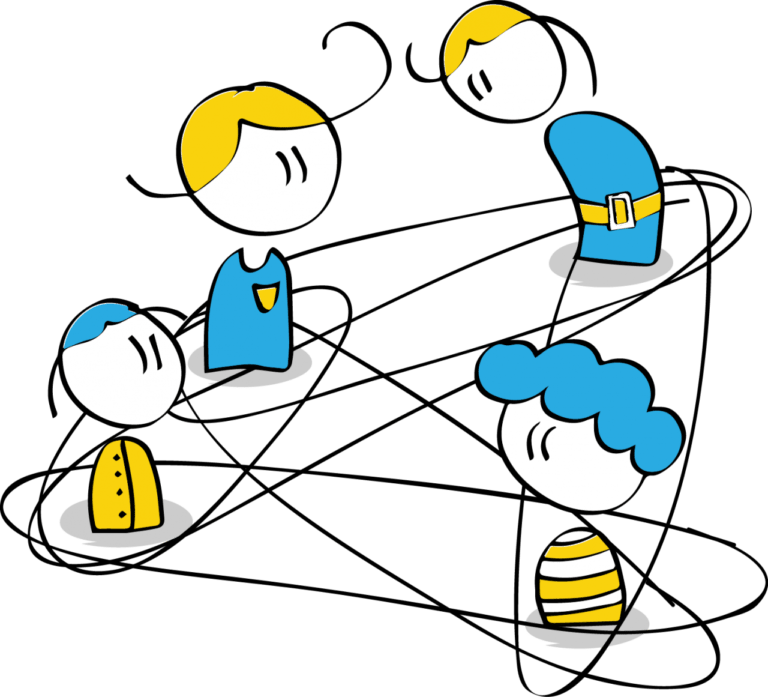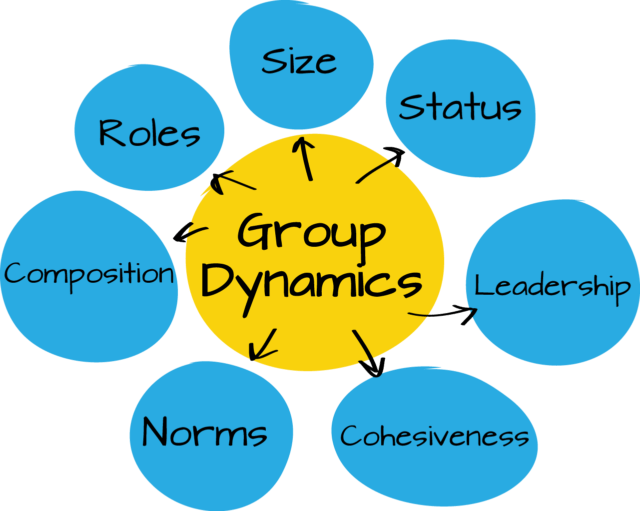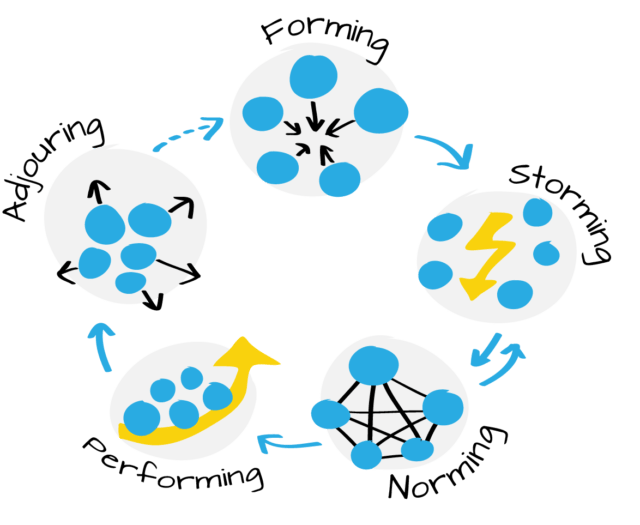
Imagine a situation. There is a room full of people. Some are talking to each other, some standing in a corner by themselves, some walking around. And there are some who are sitting down having a drink or a meal. Imagining such a situation seems to be easy, isn’t it. The harder part is to answer a question: Are they a group? Maybe, maybe not.
What is a group?
How can we recognise a group from just a bunch of individuals randomly appearing in one space at the same time? It seems that there is no agreement on that. If you look in Collins dictionary, there are 5 different descriptions defining a group there. It’s starting with a description you´ve read above (“A group of people or things is a number of people or things which are together in one place at one time.”) upto a description that might fit better an explanation of a team (“A group is a set of people who have the same interests or aims, and who organize themselves to work or act together.”) So, let’s assume that somewhere in between these two descriptions there lies a group.
In daily reflections more and more people speak of groups as “bubbles” hinting that there are some aspects in each bubble that define it. Some of those aspects might matter more, some might just be informative. For purposes of community work we could say that a group is a number of individuals that share some similar features. At the same time it might also make sense to differentiate such a description from the one of a team. Team (supposedly) already has a common goal, vision or interest and wishes or needs to act upon it, even if all the mentioned features were developed only by some members of the team or someone else entirely. So teams have a common direction and are involved in action. Groups on the other hand share some characteristics but do not need to or want to act upon them. That is important when we want to active groups in communities – they might still not have a clear vision or goal and/or they might not be interested or motivated to act upon it. Or they might no even be aware yet that they actually are a group. And… Not every group must necessarily become a team.
What defines a group?
Let’s return to what a group is. The diagram below shows some aspects of groups. To understand them better, let’s have a look at each of them, starting from the more informative ones towards the ones that are more important for community work.

Size
Even sociologists do not agree whether two people are already a group or if the groups start at number 3. That might not matter as much as the fact that with groups size does matter. According to the size of the group, people will have different relations with others, will dare or not to speak, will take up responsibilities. Usually, if groups are too big, they will naturally tend to divide to smaller ones according to some similarities.
Composition
What is the demographics of a group, what is their history (individually and together), their social, economic, educational status? That is the basic information, which can help us understand how to approach a certain group. When working with/in communities that might have experienced some kind of oppression, exclusion or other negative experiences it helps to be also aware of that. It is important to research to understand beforehand. One way is to do community mapping, there is a lot of research and experience with different groups out there.
Status
While the previous theme is about facts, this one is about perceptions. Where would the people like to belong? What matters to them in life? What kind of recognition do they seek? Where do they see themselves in society? Which groups do they feel they belong to? Which ones would they like to belong to? Which they would never want to belong to? All these questions define what social status we search as individuals. Knowing this might help communicate what matters to the people and leave out what might create tension. And, equally important is understanding their perception of themselves as a group. Who are the groups they are ready to make friends with, who do they perceive as enemies or “we will never ever be like them” kind? How they want to be perceived by the outside world? How much do they care about the outside world? What is their relationship to society, other people or other groups?
Cohesiveness
How do people connect to each other in the group? How do they complement each other? What are their specific assets that they can bring into the group and how does the group make use of it? This topic turns us from individual aspects to common ones. Cohesiveness is about diversity and inclusion, it focuses on ways how individuals as pieces of a group puzzle fit together.
Roles
With this topic we are moving into the direction of a team. There are different theories defining composition of roles in groups and in teams. Many are more relevant rather to teams, so let´s have a look at one of those that fit a group as well. There are four categories of roles that are relevant for groups:
- Task roles (Task Leader, Information Gatherer, Opinion Gatherers, Devil’s Advocate, Energizer)
- Social-emotional roles ((Encourager, Follower, Tension Releaser, Compromiser)
- Procedural roles (Facilitator, Gatekeeper, Recorder)
- Individual roles (Aggressor, Blocker, Self-Confessor, Playboy or Playgirl, Joker or Clown)
Some of those roles support group building (especially the first two) while others might hinder it (especially the last group of roles) If you would like to know more about that, visit this site.
Norms
Rules, standards, principles or taboos. Norms are all the things that explain what is and what is not acceptable in a certain group. Some of those things might be continuously shared or agreed upon while others might be unconscious and unspoken. That also means that some of the norms group members will be able to tell you (“of course, it has always been done like that”) while others we might need to observe ourselves.
Leadership
Even in groups there is some need for organisation and some people need to be actively working for the benefit of each group. Leadership can be viewed in terms of roles necessary to make sure a group will function. It might be also understood as a way to keep goals and visions in groups alive, so in this sense leadership is guidance towards (a more positive) future. Yet leadership can also be about power. It is still quite common to hear that for a group to function, it needs a strong leader. Does it?
How does a group evolve?
Groups as well as teams evolve. There are stages that help a number of individual units become one organism. Some of those stages are more relevant for teams, yet others are equally important to groups.
Tuckmann described 5 stages of group development. The stages are forming, storming, norming, performing and adjourning. In each stage, the group and its members focus on different issues to deal with.

In the forming stage, members concentrate on finding their own space in the group, discovering who others are and even think whether they want to be part of the group and under what conditions.
In the storming stage people focus on confirming their place in the group. Divisions into us and them happen very often, strong positions of right and wrong may appear and creating a common agreement might be close to impossible.
The norming stage turns the chaos into order. In this stage the group defines what is share and what group members want to have in common and what, on contrary, does not need to be shared by all group members.
Very often these two stages repeat themselves several times. Sometimes, groups do not even manage to move past them before the saying good-bye moment comes knocking at the door.
Performing is the moment when everything runs smoothly, each member of the group knows their place and role and everyone works their best for the benefit of the group (and its goal if there is one).
Adjourning is the farewell, it is the moment when to close, evaluate what happened, celebrate the successes and say good-bye. This phase is often underestimated, especially when working in communities when it seems that people will be there forever. Yet, there might be many things that actually bring a group to its natural end. Some people leave, others join, the event you organised is over, the topic you were focusing on has changed. All of these, and many more, are moments when the specific group that you have established starts to change, the group won´t be the same anymore – so it needs to go through the previous stages again. Maybe the stages will take less time or maybe they won’t be as demanding as they were previously, yet they do need to happen.
Groups and communities – why does it matter?
To make things simple – working with a community means working with a group, not only with individuals. To make things more complicated – there is not just one group in a community. There are more. And usually each of the groups is in a different stage of development, each approaches other groups differently and might or might not be open to cooperate or even to talk to each other. Knowing what groups there are, what their relationships are and what history they carry with them might help us support the community in becoming an actual community, where people interact, share and care.
